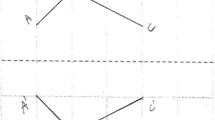Abstract
This study has two main goals: (1) to investigate the processes involved in visual estimation (part I of the study), and (2) to investigate the processes of judgment in visual estimation situations, which mostly involved proportional reasoning (part II). The study was conducted with 9-year old children in the third grade. Four strategies were expressed by the children in visual estimation situations. Exposure to a unit in the Agam project, designed to enhance visual estimation capabilities resulted in changes in the children's strategies. These changes reflected the processes by which children overcame their limited ability to process visual information. The development of proportional reasoning was investigated through a series of judgment situations. Although, as was expected, most of the children showed an additive behavior, these situations stimulated some children towards qualitative proportional reasoning, where easy/difficult considerations played an important role.
Similar content being viewed by others
REFERENCES
Behr, M. J., Harel, G., Post, T. and Lesh, R.: 1992, ‘Rational number, ratio, and proportion’, in D. A. Grouws (Ed.), Handbook of Research on Mathematics Teaching and Learning, Macmillan, New York: 296–333.
Bryant, P.: 1974, Perception and Understanding in Young Children Methuen, London.
Clements, D. H., and Battista, M. T.: 1992, ‘Geometry and spatial reasoning’, in D. A. Grouws (Ed.), Handbook of Research on Mathematics Teaching and Learning, Macmillan, New York, 420–464.
Eylon, B. S. and Rosenfeld S.: 1990, The Agam Project — Cultivating Visual Cognition in Young Children. A Research and Development Report on the Agam Project, Department of Science Teaching, the Weizmann Institute of Science, Rehovot, Israel.
Folk, C. L., Egeth, H., and Kwak, H.: 1988, ‘Subitizing: Direct apprehension or seria processing?’, Perception & Psycho physical 44,(4), 313–320.
Glinner, G. S.: 1991, ‘Factors contributing to success in mathematics estimation in preservice teachers: Types of problems and previous mathematical experience’, Educational Studies in Mathematics 22, 595–606.
Hart, K.: 1988, Ratio and Proportion. In J. Hiebert & M. Behr (Eds.), Research Agenda for Mathematics Education: Number Concepts and Operations in the Middle Grades, Erlbaum and Reston, Hillslade, NJ, National Council of Teachers of Mathematics, VA, 198–219.
Hershkowitz, R. and Markovits, Z.: 1992, ‘Conquer mathematics concepts by developing visual thinking’, Arithmetic Teacher 39(9), 38–41.
Hildreth, D. J.: 1983, ‘The use of strategies in estimating measurement’, Arithmetic Teacher 30, 50–56.
Karplus, E. F., Karplus, R. and Wollman, W.: 1974, ‘Intellectual development beyond elementary school IV: ratio, the influence of cognitive style’, School Science and Mathematics 74, 476–494.
Karplus, R., Pulos, S., and Stage, E. K.: 1983, ‘Proportional reasoning of early adolescents’, in R. Lesh and M. Landau (Eds.), Acquisition of Mathematics Concepts and Processes, Academic Press, London, 45–90.
Lamon, S. J. (1993).: ‘Ratio and proportion: Connecting content and children's thinking’, Journal for Research in Mathematics Education 24,(1), 41–61.
Lesh, R., Post, T. and Behr, M.: 1988, ‘Proportional reasoning’, in J. Hiebert and M. Behr (Eds.), Research Agenda for Mathematics Education: Number Concepts and Operations in the Middle Grade, Erlbaum and Reston, Hillsdale, NJ, National Council of Teachers of Mathematics, VA, 93–118.
Markovits, Z.: 1987, Estimation — Research and Curriculum Development, Unpublished Doctoral Dissertation, The Weizmann Institute of Science, Rehovot, Israel.
Markovits, Z. and Hershkowitz, R.: 1993, ‘Visual estimation of discrete quantities’, Zentralblatt fur Didaktik der Mathematik 93/4, 137–140.
Markovits, Z. and Sowder, J.: 1994, ‘Developing number sense: An intervention study in grade 7’, Journal for Research in Mathematics Education 25(1), 4–29.
Nunes, T., Schliemann, A. D. and Carraher, D. W.: 1993, Street Mathematics and School Mathematics, Cambridge University Press, 77–126.
Razel, M. and Eylon, B.: 1990, ‘Development of visual cognition: Transfer effects of the Agam Program’, Journal of Applied Developmental Psychology 11, 459–485.
Reys, R. E., Rybolt, J. F., Bestgen, B. J. and Wyatt J. W.: 1982, ‘Processes used by good computational estimators’, Journal for Research in Mathematics Education 13, 183–201.
Sowder, J. T. and Markovits, Z.: 1990, ‘Relative and Absolute error in computational estimation’, in G. Booker, P. Cobb and T. N. de Mendicuti, (Eds.) Proceedings of the 14th PME Conference, Vol. III, Mexico, 321–328
Author information
Authors and Affiliations
Rights and permissions
About this article
Cite this article
Markovits, Z., Hershkowitz, R. Relative and absolute thinking in visual estimation processes. Educational Studies in Mathematics 32, 29–47 (1997). https://doi.org/10.1023/A:1002911812669
Issue Date:
DOI: https://doi.org/10.1023/A:1002911812669




